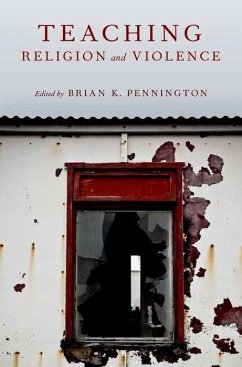Teaching Religion and Violence
Herausgeber: Pennington, Brian K
Teaching Religion and Violence
Herausgeber: Pennington, Brian K
- Gebundenes Buch
- Merkliste
- Auf die Merkliste
- Bewerten Bewerten
- Teilen
- Produkt teilen
- Produkterinnerung
- Produkterinnerung
Teaching Religion and Violence is designed to help instructors to equip students to think critically about religious violence, particularly in the multicultural classroom.
Andere Kunden interessierten sich auch für
![Teaching Religion Using Technology in Higher Education Teaching Religion Using Technology in Higher Education]() Teaching Religion Using Technology in Higher Education180,99 €
Teaching Religion Using Technology in Higher Education180,99 €![Teaching and Learning in College Introductory Religion Courses Teaching and Learning in College Introductory Religion Courses]() Barbara E WalvoordTeaching and Learning in College Introductory Religion Courses49,99 €
Barbara E WalvoordTeaching and Learning in College Introductory Religion Courses49,99 €![Teaching and Learning in College Introductory Religion Courses Teaching and Learning in College Introductory Religion Courses]() Barbara E WalvoordTeaching and Learning in College Introductory Religion Courses131,99 €
Barbara E WalvoordTeaching and Learning in College Introductory Religion Courses131,99 €![Teaching Undergraduate Research in Religious Studies Teaching Undergraduate Research in Religious Studies]() Bernadette McNary-ZakTeaching Undergraduate Research in Religious Studies126,99 €
Bernadette McNary-ZakTeaching Undergraduate Research in Religious Studies126,99 €![Oxford Handbook of Religion and Violence Oxford Handbook of Religion and Violence]() Oxford Handbook of Religion and Violence222,99 €
Oxford Handbook of Religion and Violence222,99 €![Beyond Violence Beyond Violence]() Gerard VanderhaarBeyond Violence23,99 €
Gerard VanderhaarBeyond Violence23,99 €![Relating Religion Relating Religion]() Jonathan Z. SmithRelating Religion41,99 €
Jonathan Z. SmithRelating Religion41,99 €-
-
-
Teaching Religion and Violence is designed to help instructors to equip students to think critically about religious violence, particularly in the multicultural classroom.
Hinweis: Dieser Artikel kann nur an eine deutsche Lieferadresse ausgeliefert werden.
Hinweis: Dieser Artikel kann nur an eine deutsche Lieferadresse ausgeliefert werden.
Produktdetails
- Produktdetails
- Verlag: Hurst & Co.
- Seitenzahl: 368
- Erscheinungstermin: 27. April 2012
- Englisch
- Abmessung: 236mm x 157mm x 30mm
- Gewicht: 617g
- ISBN-13: 9780195372427
- ISBN-10: 0195372425
- Artikelnr.: 35054843
- Herstellerkennzeichnung
- Libri GmbH
- Europaallee 1
- 36244 Bad Hersfeld
- gpsr@libri.de
- Verlag: Hurst & Co.
- Seitenzahl: 368
- Erscheinungstermin: 27. April 2012
- Englisch
- Abmessung: 236mm x 157mm x 30mm
- Gewicht: 617g
- ISBN-13: 9780195372427
- ISBN-10: 0195372425
- Artikelnr.: 35054843
- Herstellerkennzeichnung
- Libri GmbH
- Europaallee 1
- 36244 Bad Hersfeld
- gpsr@libri.de
Brian K. Pennington is Associate Professor of Religion at Maryville College.
* Contributors
* Introduction by Brian K. Pennington
* Part One: Traditions
* Chapter One: Striking the Delicate Balance: Teaching Hinduism and
Violence by Brian K. Pennington
* Chapter Two: ''A Time for War and a Time for Peace'': Teaching
Religion and Violence in the Jewish Tradition by Michael Dobkowski
* Chapter Three: Teaching Buddhism and Violence by Brian Victoria
* Chapter Four: Violence and Religion in the Christian Tradition by
William Morrow
* Chapter Five: Confronting Misoislamia: Teaching Religion and Violence
in Courses on Islam by Amir Hussain
* Chapter Six: The Specter of Violence in Sikh Pasts by Anne Murphy
* Part Two: Approaches
* Chapter Seven: Cities of Gold: Teaching Religion and Violence through
''Sacred Space'' by Aaron W. Hughes
* Chapter Eight: Believing Is Seeing: Teaching Religion and Violence in
Film by Ken Derry
* Chapter Nine: Teaching Religion, Violence, and Pop Culture by Randal
Cummings
* Chapter Ten: Religion, Violence, and Politics in the United States by
Jason C. Bivins
* Chapter Eleven: M. K. Gandhi: A Post-colonial Voice by Paul Younger
* Chapter Twelve: Teaching the Just War Tradition by William French
* Chapter Thirteen: Understanding the Nature of Our Offense: A Dialogue
on the Twenty-First-Century Study of Religion for Use in the
Classroom by Laurie L. Patton and Jeffrey J. Kripal
* Introduction by Brian K. Pennington
* Part One: Traditions
* Chapter One: Striking the Delicate Balance: Teaching Hinduism and
Violence by Brian K. Pennington
* Chapter Two: ''A Time for War and a Time for Peace'': Teaching
Religion and Violence in the Jewish Tradition by Michael Dobkowski
* Chapter Three: Teaching Buddhism and Violence by Brian Victoria
* Chapter Four: Violence and Religion in the Christian Tradition by
William Morrow
* Chapter Five: Confronting Misoislamia: Teaching Religion and Violence
in Courses on Islam by Amir Hussain
* Chapter Six: The Specter of Violence in Sikh Pasts by Anne Murphy
* Part Two: Approaches
* Chapter Seven: Cities of Gold: Teaching Religion and Violence through
''Sacred Space'' by Aaron W. Hughes
* Chapter Eight: Believing Is Seeing: Teaching Religion and Violence in
Film by Ken Derry
* Chapter Nine: Teaching Religion, Violence, and Pop Culture by Randal
Cummings
* Chapter Ten: Religion, Violence, and Politics in the United States by
Jason C. Bivins
* Chapter Eleven: M. K. Gandhi: A Post-colonial Voice by Paul Younger
* Chapter Twelve: Teaching the Just War Tradition by William French
* Chapter Thirteen: Understanding the Nature of Our Offense: A Dialogue
on the Twenty-First-Century Study of Religion for Use in the
Classroom by Laurie L. Patton and Jeffrey J. Kripal
* Contributors
* Introduction by Brian K. Pennington
* Part One: Traditions
* Chapter One: Striking the Delicate Balance: Teaching Hinduism and
Violence by Brian K. Pennington
* Chapter Two: ''A Time for War and a Time for Peace'': Teaching
Religion and Violence in the Jewish Tradition by Michael Dobkowski
* Chapter Three: Teaching Buddhism and Violence by Brian Victoria
* Chapter Four: Violence and Religion in the Christian Tradition by
William Morrow
* Chapter Five: Confronting Misoislamia: Teaching Religion and Violence
in Courses on Islam by Amir Hussain
* Chapter Six: The Specter of Violence in Sikh Pasts by Anne Murphy
* Part Two: Approaches
* Chapter Seven: Cities of Gold: Teaching Religion and Violence through
''Sacred Space'' by Aaron W. Hughes
* Chapter Eight: Believing Is Seeing: Teaching Religion and Violence in
Film by Ken Derry
* Chapter Nine: Teaching Religion, Violence, and Pop Culture by Randal
Cummings
* Chapter Ten: Religion, Violence, and Politics in the United States by
Jason C. Bivins
* Chapter Eleven: M. K. Gandhi: A Post-colonial Voice by Paul Younger
* Chapter Twelve: Teaching the Just War Tradition by William French
* Chapter Thirteen: Understanding the Nature of Our Offense: A Dialogue
on the Twenty-First-Century Study of Religion for Use in the
Classroom by Laurie L. Patton and Jeffrey J. Kripal
* Introduction by Brian K. Pennington
* Part One: Traditions
* Chapter One: Striking the Delicate Balance: Teaching Hinduism and
Violence by Brian K. Pennington
* Chapter Two: ''A Time for War and a Time for Peace'': Teaching
Religion and Violence in the Jewish Tradition by Michael Dobkowski
* Chapter Three: Teaching Buddhism and Violence by Brian Victoria
* Chapter Four: Violence and Religion in the Christian Tradition by
William Morrow
* Chapter Five: Confronting Misoislamia: Teaching Religion and Violence
in Courses on Islam by Amir Hussain
* Chapter Six: The Specter of Violence in Sikh Pasts by Anne Murphy
* Part Two: Approaches
* Chapter Seven: Cities of Gold: Teaching Religion and Violence through
''Sacred Space'' by Aaron W. Hughes
* Chapter Eight: Believing Is Seeing: Teaching Religion and Violence in
Film by Ken Derry
* Chapter Nine: Teaching Religion, Violence, and Pop Culture by Randal
Cummings
* Chapter Ten: Religion, Violence, and Politics in the United States by
Jason C. Bivins
* Chapter Eleven: M. K. Gandhi: A Post-colonial Voice by Paul Younger
* Chapter Twelve: Teaching the Just War Tradition by William French
* Chapter Thirteen: Understanding the Nature of Our Offense: A Dialogue
on the Twenty-First-Century Study of Religion for Use in the
Classroom by Laurie L. Patton and Jeffrey J. Kripal








